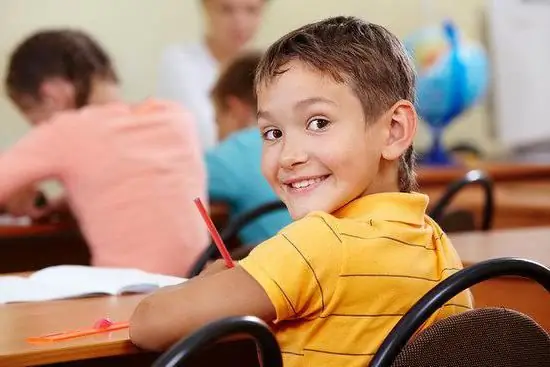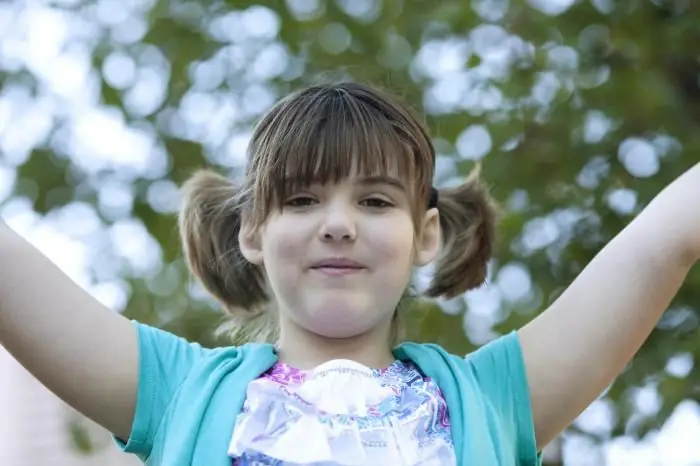2025 Author: Priscilla Miln | [email protected]. Last modified: 2025-01-22 17:55:22
One of the activities performed during the examination by a pediatrician is the counting of respiratory movements. This simple at first glance indicator provides important information about the state of he alth in general and about the functioning of the respiratory and cardiovascular systems in particular.

How to correctly calculate the respiratory rate (RR) per minute? This is not particularly difficult. However, there are some difficulties in interpreting the data. This is more true for young parents, because, having received a result from a child that is several times higher than their own, they panic. Therefore, in this article, we still propose to figure out what is the norm of NPV in children. The table will help us with this.
Features of the child's respiratory system
The first thing a future mother has been waiting for is the baby's first cry. It is with this sound that his first breath occurs. By the time of birth, the organs that ensure the child's breathing are not yet fully developed, and only with the growth of the organism itself do they mature (both functionally and morphologically).
Nasal passages (which are the upper respiratory tract) in newborns have their own characteristics:
• They are quite narrow.
• Relatively short.• Their inner surface is tender, with a huge number of vessels (blood, lymph).

Therefore, even with minor catarrhal phenomena, the nasal mucosa in a child quickly swells, and the small clearance decreases, as a result - breathing becomes difficult, shortness of breath develops: young children cannot yet breathe through their mouths. The younger the child, the more dangerous the consequences can be, and the faster the pathological condition must be eliminated.
Lung tissue in young children also has its own characteristics. They, unlike adults, have poorly developed lung tissue, and the lungs themselves have a small volume with a huge number of blood vessels.
Respiratory rate counting rules
Measuring the respiratory rate does not require any special skills or equipment. All you need is a stopwatch (or a watch with a second hand) and some simple rules.
A person should be in a calm state and in a comfortable position. If we are talking about children, especially at an early age, then the calculation of respiratory movements is best done in a dream. If this is not possible, the subject should be distracted from the manipulation as much as possible. To do this, it is enough to take hold of the wrist (where the pulse is usually determined) and in the meantime count the respiratory rate. It should be noted that the pulse in children under one year old (about 130-125 beats per minute)should not cause concern - this is the norm.

In infants, it is strongly recommended to count the respiratory rate during sleep, since crying can significantly affect the result and give deliberately false numbers. By placing your hand on the anterior abdominal wall (or just visually), you can easily conduct this study.
Given that breathing has its own rhythmic cycle, it is necessary to observe the duration of its count. Be sure to measure the respiratory rate for a full minute, and not multiply the result obtained in just 15 seconds by four. It is recommended to carry out three counts and calculate the average.
Normal respiratory rate in children
The table shows the norms of the frequency of respiratory movements. The data are presented for children of different age groups.

As you can see from the table, the frequency of respiratory movements per minute is higher, the younger the child. Gradually, as they grow older, their number decreases, and by the pubertal period, when the child is 14-15 years old, the respiratory rate becomes equal to this indicator in an adult he althy person. There are no gender differences.
Types of breathing
There are three main types of breathing in both adults and children: chest, abdominal and mixed.
The chest type is more characteristic of the female. With it, inhalation / exhalation is provided to a greater extent due to the movements of the chest. The disadvantage of this type of respiratorymovements is poor ventilation of the lower parts of the lung tissue. Whereas in the abdominal type, when the diaphragm is more involved (and the anterior abdominal wall visually moves during breathing), the upper sections of the lungs experience a lack of ventilation. This type of breathing movement is more typical for men.
But with a mixed type of breathing, a uniform (equal) expansion of the chest occurs with an increase in the volume of its cavity in all four directions (upper-lower, lateral). This is the most correct type of breathing, which ensures optimal ventilation of the entire lung tissue.
Normally, the respiratory rate in a he althy adult is 16-21 per minute, in newborns - up to 60 per minute. Above, the rate of respiratory rate in children is given in more detail (table with age norms).

Easy breathing
The first sign of damage to the respiratory system, especially in infectious diseases, is rapid breathing. In this case, there will certainly be other signs of a cold (cough, runny nose, wheezing, etc.). Quite often, with an increase in body temperature, the respiratory rate increases and the pulse quickens in children.
Holding your breath while sleeping
Quite often in young children (especially infants) in a dream there are short-term pauses in the duration of breathing. This is a physiological feature. But if you notice that these episodes become more frequent, they last longer, or other symptoms occur, such as blue lips or nasolabi altriangle, loss of consciousness, you must immediately call an ambulance to prevent irreversible consequences.

Conclusion
Respiratory organs in young children have a number of features that contribute to their frequent damage and rapid decompensation of the condition. This is primarily due to their immaturity at the time of birth, certain anatomical and physiological features, incomplete differentiation of the structures of the central nervous system and their direct effect on the respiratory center and respiratory organs. The younger the child, the smaller the volume of lungs possesses, therefore, he will need to make more respiratory movements (inhalation / exhalation) in order to provide the body with the necessary amount of oxygen.

Summing up
It should be remembered that in children of the first months of life, respiratory arrhythmia is quite common. Most often, this is not a pathological condition, but only indicates age-related features.
So, now you know what is the norm of NPV in children. The table of averages should be taken into account, but small deviations should not be panicked. And be sure to check with your doctor before jumping to conclusions!
Recommended:
Comic tasks for guests at the birthday table. Comic New Year's tasks for guests at the table

Our people love holidays. And most often most of them take place in the form of feasts. After all, it is the easiest way to communicate with family and friends. However, so that people do not get bored, you can periodically entertain them by distracting them from eating and talking. That is why now I want to consider various comic tasks for guests at the table
Identification and development of gifted children. Problems of gifted children. School for gifted children. Gifted children are

Who exactly should be considered gifted and what criteria should be followed, considering this or that child the most capable? How not to miss the talent? How to reveal the hidden potential of a child who is ahead of his peers in terms of his level of development, and how to organize work with such children?
How to choose a table clock? How to set up a desktop clock? Table clock mechanism

Desk clocks are needed in the house not only to show the time. They can perform a decorative function and become a decoration for an office, bedroom or children's room. To date, a huge range of these products is presented. They differ from each other according to such factors and criteria as the table clock mechanism, appearance, material of manufacture. What to choose among such a variety? It all depends on the desire of the consumer
Lymphocytes in children are normal. Lymphocytes in children (normal) - table

A blood test is prescribed to make sure the presence or absence of various diseases. There are white and red cells in the blood. Lymphocytes are white cells. Experts pay special attention to their number, as they can indicate very dangerous diseases. How many should there be and what is the norm for children?
Weight and height of children: WHO table. Age tables of the norm of height and weight of children

Each appointment with a pediatrician in the first 12 months of a baby's life ends with a mandatory measurement of height and weight. If these indicators are within the normal range, then it can be argued that the child is well developed physically. To this end, the World He alth Organization, briefly WHO, has compiled age tables of the norm of height and weight of children, which are used by pediatricians when assessing the he alth of babies

